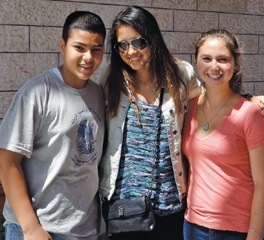JWeekly.com
by ariel schnitzer

If it weren’t for the Hebrew exit sign hanging above the school’s entrance, I would have never imagined I was in Israel, or rather, the Israel that I had always known. Boys played soccer, girls gossiped in tight groups.
I was in Ramle, and this was my first time in an Arab high school. I was there as part of Kivunim: New Dir-ections, a gap-year program that seeks to build relationships between Jewish and Arab students that hopefully will better our understanding of each another.
I had visited Israel in the past, returning home believing that I had fully experienced what it was like to live there, but I had never been exposed to Israel’s largest minority. I was excited, yet anxious, to be part of the first meaningful interaction these Arab high school students would have with their Jewish peers. That they were Israeli citizens, but had never had any kind of relationship with another Jew, shocked me.
I spent a year on the program, living in Jerusalem with the other North American participants. Once a week, on Thursday mornings, eight of us piled into our van and made the 45-minute journey from Jerusalem to the Christian Orthodox School in Ramle. Although Christian Arabs run the school, the overwhelming majority of the students are Muslim.
On our first day, we were divided into groups of seven students per American volunteer. We began by conversing with them about hobbies, school, movies. They all wore very modern, Western-style clothing, even though some of the girls wore traditional Muslim hijabs, or head coverings. Most girls, however, walked around with no head coverings and dressed in tight skinny jeans.
Awkward at first, our conversations soon turned amiable and uninhibited.
“Where do you want to study after high school?” I asked one boy.
“Jenin,” he replied, referring to a West Bank city in the Palestinian territories.
“Why?” I asked, surprised.
“It is so beautiful there,” he said. “There are a lot of trees and I have a lot of relatives there and the education is very good. It is more peaceful … less complicated.”
Others I spoke with expressed the desire to stay in Israel.
“What do you want to study in college?” I asked a girl I had gotten to know as an ambitious and hardworking overachiever.
“Science,” she said, grinning.
“Where?” I asked.
“Hebrew University,” she answered. “It’s the best school in Israel.”
I noted that what differentiated her from the other boy was that she came from a wealthy, assimilated Arab family that had a second home in a major Israeli city. She had grown up with Jewish neighbors and her mother has worked for Jewish organizations. The other boy had spent his entire life within Ramle’s insular Arab community.
Several months later, I noticed a young girl giggling as she spoke to a large group of her friends. I asked one of the girls what was going on.
“She got engaged this past weekend,” she explained. “The school announced it over the loudspeaker this morning.”
“How old is she?” I asked, stunned.
“Fifteen,” she replied. “She’s leaving the school now.”

Ariel Schnitzer (center) is flanked by fellow Kivunim participant Gaby Belok (right) and a student at the Ramle school.
The girl told me that five or six girls a year get married and leave school. This particular girl’s fiance was “older, maybe 30,” she said. And the girl had not chosen him. “Her parents arranged it all.”
This prompted a discussion about dating. Some parents were less strict, others more conservative.
“My parents would never let me have a boyfriend!” One girl exclaimed.
Another girl said her parents weren’t religious and wouldn’t mind.
One boy said he didn’t have a girlfriend, but several moments later, admitted he did. “My parents don’t know. We meet up in secret.”
In January, Kivunim took us to the Neve Shalom School in Casablanca. During a discussion about anti-Semitism in Morocco, Rabbi Jacquy Sebag drew our attention to a faint scar that divided his face into two. A man had attacked him with an ax because he was Jewish. Despite this, Rabbi Sebag still views himself as Moroccan first rather than a Jew who happens to live in Morocco, and he continues to engage with his local Muslim community.
I returned to Ramle with newfound energy, determined to use Rabbi Sebag’s example as a member of a religious minority to connect better with the Ramle students who viewed themselves, rightly or wrongly, as victims of discrimination and distrust.
The students and I began to discuss the Arab-Israeli conflict and the tensions between the Arab and Jewish citizens of Israel. Although I identify as pro-Israel, I listened to them argue their opinions and describe their encounters with prejudiced Jews and biased policemen. In turn, I hoped the Ramle students acquired a new outlook on Jewish youth, that there are some who want to listen to them.
“Tell me about some of your experiences with Jews,” I asked one boy.
He frowned. “The only experience I’ve ever had with Jews is one time my father and I were walking through the Jewish Quarter of Jerusalem. It was Yom Kippur, but we didn’t know that. A crowd of Jewish men began following us, hurtling stones at our backs. It made me so mad.” He paused, then added, “It still does.”
Most of the students expressed frustration that the school’s curriculum failed to address the Arab-Israeli conflict.
“I get most of my information from my home, from my parents,” said one student.
“The administration praises the Israeli government and remains hush-hush about the Arab side,” another student complained. “As a result, I know a lot of math, geography and literature, but I know nothing about the conflict.”
One girl was even more irate. She complained that she was never taught about her Palestinian culture in school, and was taught history only from the Israeli perspective. She felt that her textbooks did not contain enough information about her heritage.
I realized the unique position of Israeli Arabs, particularly the Muslims. They share a heritage and religion with other Arabs, yet they live in a Jewish state. They are criticized by non-Israeli Arabs for living in Israel, yet many Israeli Jews want as little to do with them as possible. Many feel ostracized, isolated and shunned.
Ramle raised my awareness of the discrimination and frustration that many Israeli Arabs experience on a regular basis. I learned that it is much more difficult for these students to get admitted to the best Israeli universities because as Arabs, they don’t do compulsory military service.
Interestingly, except for a handful who wanted to move abroad, either to Palestinian-controlled territories or other countries, most of the kids I met were positive about Israel despite the challenges they faced. Many hoped to become lawyers, doctors and teachers — in Israel. Many of them loved living in Ramle, and hoped to raise their families in this warm community.
During my year in Israel, I was also exposed to the generosity and warmth of the Israeli Arab culture. Kids offered to share their lunches and the “lunchmen” gave us free falafels. Each time I came to Ramle I stopped by the local bakery, which smelled of freshly baked Middle Eastern pastries. The owner came to recognize us, eager to have us choose our choice of sweets for the day from the old-fashioned shelves carved into the wall.
I don’t know if I will ever see these students again. But the stories I heard, and the anger and frustration, hope and optimism I witnessed made an indelible mark on me.
My advice to anyone planning a gap year in Israel is to enjoy every moment. And remember to keep an open mind. You never know whom you might meet and, most important, what they will teach you.
Ariel Schnitzer does volunteer and community service work in Los Angeles and has family in the Bay Area.






